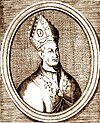Philippe de Cabassoles
Philippe de Cabassoles | |
|---|---|
 | |
| Born | 1305 Avignon Cavaillon, France |
| Died | 27 August 1372 |
| Other names | Cardinal of Jerusalem |
| Parent | father: Isnard de Cabassole |
| Ordained | 1317 |
Offices held | Bishop of Cavaillon Cardinal Priest of Saints Peter and Marcellinus Cardinal Bishop of Sabina (1368-1372) |
| Title | Canon of the cathedral chapter of Cavaillon |

Philippe de Cabassole or Philippe de Cabassoles (1305–1372), the
Early life
Philippe was educated by the clergy of Cavaillon and was made Canon of the cathedral chapter of Cavaillon on 22 March 1328. He next was promoted to
Middle life
Philip was elected bishop of Cavaillon on 17 August 1334. He attended the Council of Avignon in 1337. Philip became guardian of
The best friend of Petrarch
Philippe formed a long lasting friendship with Petrarch from 1337 until his death in 1372.[7] Philippe had a villa not far from Avignon in the village of Vaucluse high on a cliff with a view.[8] Petrarch built a home in Vaucluse after visiting his friend Philippe, who had built his castle on the site of a 7th-century BC Oppidum. From Philippe's castle the view was beautiful and is no wonder the bishop selected this lofty spot.

Living just a short twenty-minute walk from one another, they developed a very close relationship that lasted a lifetime. Petrarch dedicated a book to his friend, who "treated him as a brother", despite his later status as Cardinal. Among the intimates of Petrarch's old age there seems to be only one name missing in Petrarch's will, which is Philippe's. Their friendship had begun in 1337 when Petrarch moved to
Petrarch made a collection of 350 letters he personally wrote called Epistolae familiares (a.k.a.
Historian Wilkens tells of part of a letter Petrarch sent to Philip in 1371 that shows their friendship,
May God grant that I regain enough health and strength to make it possible for me to fulfill my heart's desire - a desire made still stronger by the news of your being here among us - my desire to see you once more. But in this, as in all else, God's will be done. If that desire is not to be fulfilled on earth, I shall see you again, God willing, in our heavenly fatherland. Oh may Christ the Lord not deny me this, that after my death I may no longer be separated from him who was so dear to me in this mortal life! [16]
Death and after
Pope Gregory XI sent Philippe to
Works
- Life of St. Mary Magdalene (Libellus hystorialis Marie beatissime Magedelene) - 1355.
Footnotes
- ^ Calthrop Hollway-Calthrop, pp. 83-84
- ^ Cook, pp. 341-342
- ^ Aldonce, pp. 120-121
- ^ The Cardinals of the Holy Roman Church, Biographical Dictionary, biography of CABASSOLE, Philippe de (1305-1372)
- ^ "Fasti Ecclesiae Anglicanae 1300-1541: volume 6: Northern province (York, Carlisle and Durham)". Retrieved 2012-01-21.
- ^ "Fasti Ecclesiae Anglicanae 1300-1541: volume 1: Lincoln diocese". Retrieved 2012-01-21.
- ^ Catholic Encyclopedia, "Archdiocese of Avignon."
- ^ Cook, pp. 340-341
- ^ Speculum (Jul 1963), Medieval Academy of America, Vol. 38, No. 3, p. 453
- ^ On Philippe de Cabassoles see Martellotti's introductory remarks in his edition and Italian translation of "De Vita Solitaria" in Petrarca, Prose, page 286.
- ^ Petrarch's Last Will: A Personal Document of his Old Age introduction pages 20 through 22 by Theodor E. Mommesen, Cornell University Press, 1957.
- ^ Familiar Letters - XI, XII, XV, XXII, and XXIV letters to Philippe.
- ^ Hermitary - resources and reflections on hermits and solitude.
- ^ Some short extracts from Petrarch’s Life of Solitude, written to Philippe Archived 2009-01-29 at the Wayback Machine
- ^ Speculum (Jan 1960), Medieval Academy of America, Vol. 35, No. 1, p. 70
- ^ Speculum (Jan 1960), Medieval Academy of America, Vol. 35, No. 1, p. 77
- ^ Speculum (Jan 1960), Medieval Academy of America, Vol. 35, No. 1, p. 76
- ^ Cook, p. 342
See also
References
- Aldonce, Jacques François Paul de Sade, The Life of Petrarch, collected from Memoires pour la vie de Petrarch, vol. 1, London, Vernor & Hood, 1797.
- Calthrop Hollway-Calthrop, Henry, Petrarch: his life and times, G.P. Putnam's sons, 1907
- Cook, Sir Theodore Andrea, Old Provence, Volume 2, C. Scribner's Sons, 1905
- This article incorporates text from the old Catholic Encyclopediaof 1914, a publication now in the public domain.
- This article incorporates text from the Schaff-Herzog Encyclopedia of Religious Knowledge, a publication now in the public domain.
Further reading
- Aldonce, Jacques François Paul de Sade, The Life of Petrarch, collected from Memoires pour la vie de Petrarch, Volume 1 pp. 120–124, 130-131, 213-214, 265, 390; Volume 2 pp. 79, 147, 173, 331-332, 335, 363, 383, 385, 405
- Campbell, Thomas, Life of Petrarch , London : H. Colburn, 1841; Volume 1, p. 181; Volume 2, pp. 400, 112, 181, 285-286, 288, 293-294
